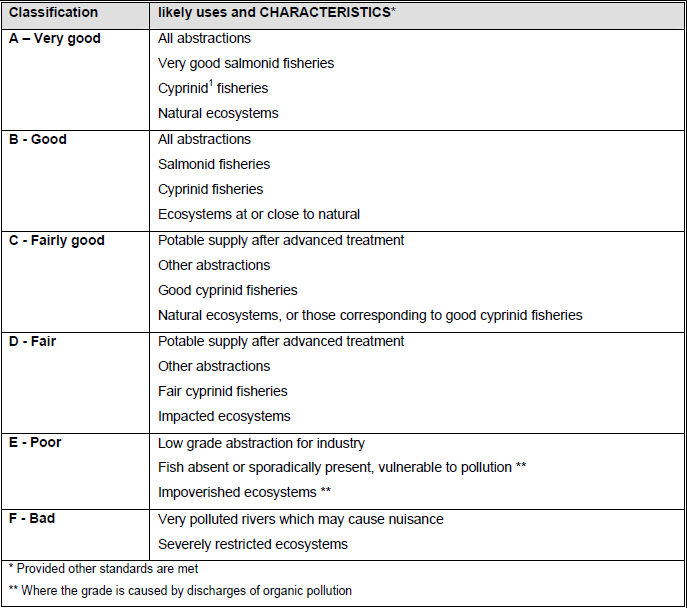Appendix 1:
Environment Agency
General Quality Assessment (GQA) Scheme
The EA has developed a General Quality Assessment scheme (GQA) which provides a consistent method for classifying water quality in rivers and canals across the UK. The scheme provides a way of comparing river quality from one river to another and for looking at changes through time.
The scheme uses four main parameters of measurement which include:
• chemical content;
• biological content;
• nutrient content; and
• aesthetics.
Chemistry
Samples are analysed for three determinands of organic pollution: ammonia, biochemical oxygen demand (BOD), and dissolved oxygen. The results for a site are averaged and percentiles are calculated. These are compared with limits set for each of six grades as shown in the Table 1.1. A grade is assigned to the length of river (which the sampling site represents) according to the lowest grade achieved by any of the three determinands. For example, if a site is grade A for dissolved oxygen and ammonia but only grade B for BOD, then the grade assigned is B.
Table 1.1 Classification: Chemistry

Biology
The macro-invertebrates (small animals that can be seen with the naked eye) found in the kick-samples taken are identified by the EA. The range of species found is compared with the range that would be expected in the river if it was not polluted or physically damaged. This takes account of natural differences expected due to different types of geology and flow, for example. One of six grades is allocated to each river length, as shown in Table 1.2.
Table 1.2: Classification: Biology

Nutrients
Samples are analysed for nitrate and phosphate. A grade is assigned for each of these
nutrients according to the Table 1.3 and Table 1.4.
Table 1.3 Classification: Nutrients - Phosphates

Table 1.4 Classification: Nutrients - Nitrates

Nitrate levels in many English surface waters are increasing. Nitrate pollution is of concern because it has to be removed before water can be supplied to consumers and may result in detrimental environmental impacts. The Nitrates Directive requires all known areas of land draining into nitrate polluted waters to be identified for designation as Nitrate Vulnerable Zones (NVZs). Therefore, if an area of land drains into one or more of the above categories of polluted water, it will be located within a NVZ. Farmers located within these NVZs are required to adhere to an Action Programme of measures to reduce the amount of nitrate lost from their land to the polluted waters
Source: http://www.environment-agency.gov.uk/